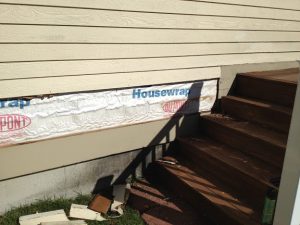Step-by-Step Instructions for Repairing House Siding
By Mark J. Donovan
|
|
Due to the weather elements and the occasional item that hits the side of the home, such as a fallen tree or baseball, repairing house siding occasionally is required. Most of the time repairing house siding involves no more than just replacing a few clapboards and then touching them up with paint. Fortunately most handy do it yourself homeowners can repair house siding with just a few basic tools and carpentry skills.
The real trick on how to repair house siding, or more specifically patch wood house siding, is in the process of removing just the damaged clapboards while leaving the other surrounding clapboards intact. |
Remove Damaged House Siding Clapboard
To make a repair patch on a damaged piece of wood house siding clapboard, first begin by carefully cutting the damaged clapboard at a location that is beyond the damaged area, and that preferably lines up over an existing wall stud.
Use a pencil and mark the location, and then score the damaged house siding clapboard repeatedly with a carpenter’s knife to create a relief line. You may want to employ a straight edge for this process.
Continue to work the pry bar up and underneath the bottom section of the damaged house siding piece, making sure not to damage the lower clapboard. You may want to use a small block of wood to act as a lever and to protect the lower house siding clapboard.
Once you have slightly lifted the damaged house siding piece away from the house sheathing, use a reciprocating saw to cut the nails on the backside of the damaged house siding piece.
After cutting the nails remove the old damaged house siding clapboard.
| Install New House Siding Patch
Once the old damaged house siding piece has been removed, check to make sure there are no stubs of nails still protruding behind the upper house siding clapboard, as you will be sliding the new house siding clapboard up underneath it. If there are cut nail stubs protruding out, use a flat-bar or pry- bar and a hammer to push the nails flush with the house sheathing. |
 |
Also pound into the sheathing any cut nail stubs associated with the damaged house siding clapboard that was removed.
Next, measure and cut a piece of new house siding.
| Then slide the new house siding patch up underneath the existing house siding clapboard that sits just above the damaged house siding piece you had earlier removed. Note it is wise to add a bead of exterior caulk on the ends of the existing house siding clapboards first before installing the new house siding clapboard.
After positioning the new house siding patch into place, fasten it to the house with galvanized nails. Finally touch up the new patch with a coat of primer if necessary, and then apply a coat of paint. With that, you have completed your first house siding repair project. |
|
Patching Wood Siding Ebook – If you require detailed instructions and pictures for patching wood siding see HomeAdditionPlus.com’s Patching Wood Siding Ebook. This Ebook provides very detailed instructions, along with pictures for each key step in the process of patching wood siding.
Related Information
Get Free Siding Price Quotes with No Obligation!
Fill out our 3-5 minute quick and easy form, and receive a free price quote on home siding from one of our prescreened and licensed siding contractors. This process is free and there is no obligation to continue once you receive your home siding estimate.

